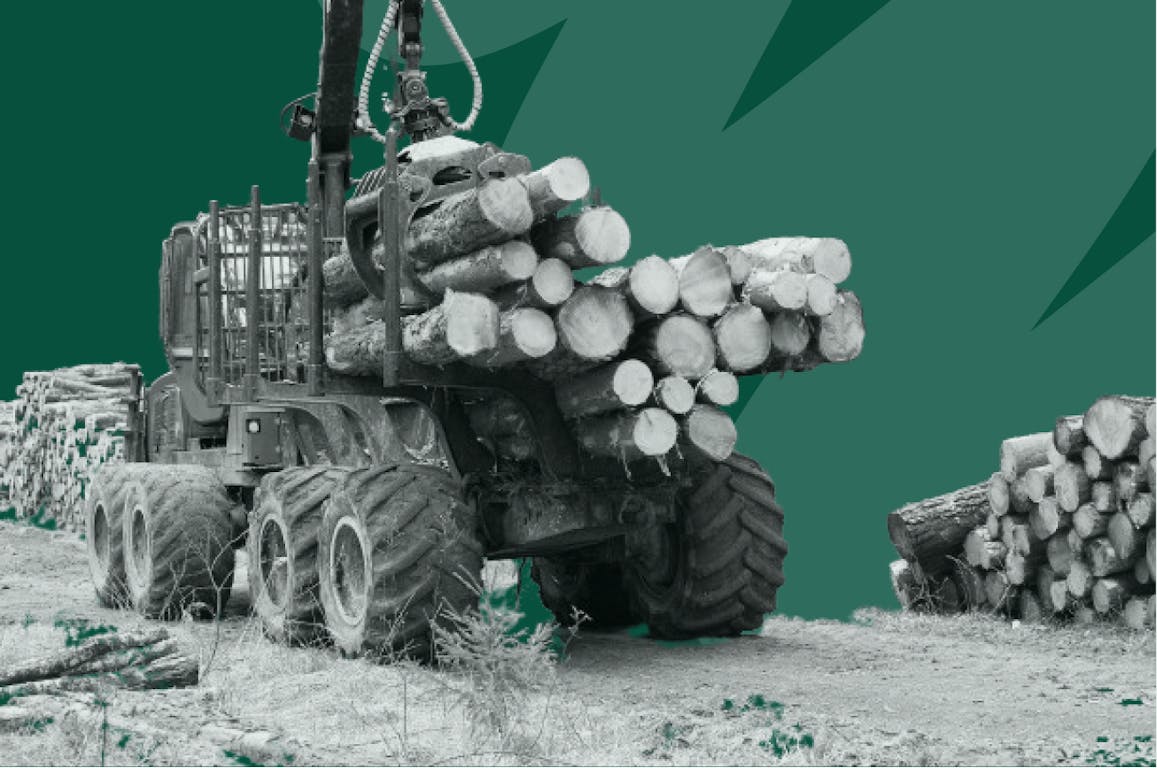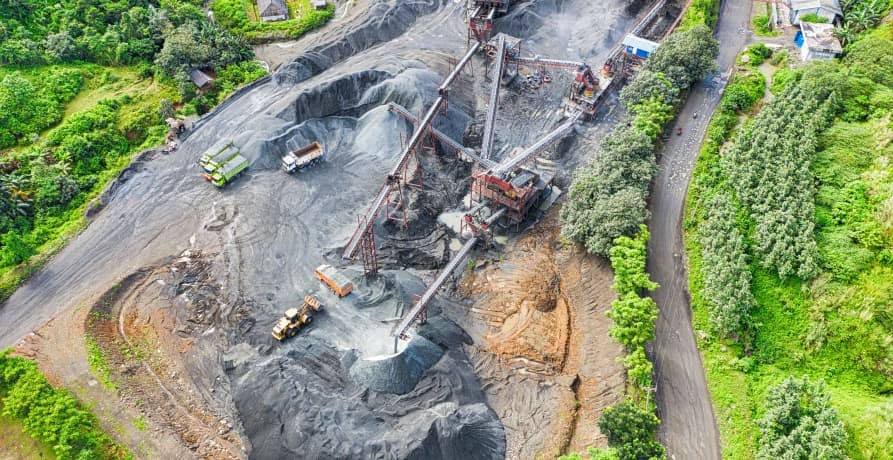ESG / CSR
Industries
Deforestation: definition, effects and solutions



This widespread practice significantly impacts crucial ecosystems, especially in areas such as the Amazon, and significantly contributes to global warming.
In this article, we delve into the various causes, the far-reaching effects, and the potential solutions to deforestation, providing a deeper understanding of how it intensifies climate change and disrupts the global ecological equilibrium.
We’ll explore deforestation, examining its causes and effects, and its connection to climate change.
What is deforestation?
Deforestation has greatly altered many landscapes around the world.
In Western Europe for example, 80 % of land was covered in forests just 2000 years ago, today this percentage is as low as 34 %. And in North America, around half of the forests in the east of the continent were cut down before the end of the 19th century for timber and to make space for farmland
Today the most alarming deforestation is taking place in tropical forests such as the Amazon. Areas of nature that were previously unreachable are now accessible for exploitation. In the Amazon for example illegal logging and farming is a significant problem, with huge sections of the rainforest being razed and burned to make way for cattle ranching, mining, and logging.
This is problematic for a whole host of reasons, not only is the Amazon rainforest the “lungs of the planet” acting as a vital carbon sink, but it is also home to many plant and animal species that can’t be found anywhere else on Earth.
Forests are vital ecosystems that support a diverse variety of life, including numerous plant and animal species. They play a vital role in maintaining the balance of the earth's environment, absorbing carbon dioxide, producing oxygen, and regulating climate patterns.
When these forested areas are removed, it not only leads to the loss of habitat for countless species but also disrupts these essential ecological functions.
The scope of deforestation is vast and ongoing. 15 billion trees are cut down every year - that’s more than 41 million trees per day. According to the United Nations, the world is losing 10 million hectares of forest every year - an area that is roughly the size of Iceland!
What are the causes of deforestation?
The permanent destruction of the Earth’s forest is by far and large a human-driven issue. We cut down or destroy trees for a variety of reasons, though often these are commercially driven. Let’s take a closer look at the primary causes of deforestation:
Agricultural expansion
The ever-growing global demand for food is the primary driver of deforestation, accounting for over 70 % of deforestation rates.
To feed the world's growing population, vast areas of forest are converted into fields and pastures. For example, in Brazil, large areas of the Amazon rainforest are cleared for soy cultivation and cattle ranching. This transformation of lush tropical forests into agricultural lands not only destroys habitats but also releases significant amounts of greenhouse gases.
Logging for commercial use
Global demand for wood and paper products has led to extensive logging, particularly in North America and Russia.
When this is done without regard for sustainable forest management it results in deforestation. Illegal logging is also a growing issue, particularly in regions like Southeast Asia and the Amazon rainforest, where such practices contribute heavily to the large-scale depletion of tropical forests.
Forests that are degraded due to logging practices are also much more vulnerable to other land uses, such as mining and agriculture. Additionally, the loss of tree canopies allows sunlight to reach the forest floor, altering the ecosystem and making it vulnerable to invasive species.
Urbanization and infrastructure development
The Earth’s population is growing and has now reached a record high of over 8 billion people.
This places enormous strain on the Earth’s resources with increased demand for not only food and water but space too. As cities and populations expand, land is lost to make way for the development of infrastructure such as roads, highways, and dams. This development often comes at the expense of forests. Urban sprawl consumes large areas of forested land, diminishing green spaces and fragmenting habitats.
Mining activities
With the demand for minerals and rare earth metals increasing (in part driven by the green transition), mining in forests is increasing.
Since the start of the century, mineral extraction has doubled, particularly in biodiverse regions like the Amazon rainforest. Unfortunately, the need for valuable minerals requires the clearing of vast areas of forests to make way for the development of infrastructure, disrupting vulnerable ecosystems and polluting the environment in the process.

Forest fires
Many forest fires, especially those in tropical regions, are not natural occurrences but are instead started intentionally to clear land quickly and cheaply for agriculture or other uses. These fires can spiral out of control, leading to extensive loss of forest cover.
For example, in Indonesia, fires are often set to clear land for palm oil plantations, causing widespread environmental destruction.
Climate change and pest infestations
Paradoxically, deforestation both contributes to and is exacerbated by climate change. Altered weather patterns can result in the destruction and degradation of forests, increasing their vulnerability to pests and diseases.
For example, extreme weather events like wildfires, droughts, and flooding destroy large areas of forests every year and these climate events are becoming increasingly frequent as global warming intensifies. Areas of degraded forests subsequently become more vulnerable to pests, diseases, and harmful invasive species. Forests that are deemed to be in poorer condition are also more likely to be subject to human-led deforestation practices.
Socio-economic factors
In many developing countries deforestation is driven by poverty and limited economic opportunities.
Local communities may be left with no choice but to resort to clearing forests for agricultural land or logging as a means of survival. This practice, driven by necessity, is a direct response to the lack of viable economic alternatives.
What are the impacts of deforestation?
Deforestation has significant and widespread impacts on both the environment and the global climate:
Loss of biodiversity
Forests are vital habitats for countless species of plants, birds, mammals, and insects. Deforestation not only destroys these habitats but also fragments them, making it difficult for species to survive and interact as they naturally would.
This fragmentation can lead to genetic isolation and reduced population viability, pushing many species towards extinction.
Learn more about the devastating impacts of biodiversity loss in our article.
Altered carbon cycles
Forests are major carbon sinks, absorbing large amounts of carbon dioxide. When they are cut down, not only is this carbon-capturing ability lost, but the stored carbon is also released back into the atmosphere, contributing significantly to climate change.
This release occurs not just from the burning of wood but also from the decomposition of leftover plant material.
To find out more about the Earth’s delicate carbon cycle head over to our blog.
Disruption of water cycles
Trees play a crucial role in maintaining local and regional water cycles.
They help in capturing and releasing water through transpiration, contributing to rainfall patterns. When forests are removed, these patterns can be significantly altered, leading to decreased rainfall in some areas and increased flooding in others.
Soil degradation
The roots of trees bind the soil, preventing erosion and maintaining soil fertility. Without this protective layer, the soil is over-exposed to wind and rain, leading to rapid erosion and the loss of nutrient-rich topsoil.
This degradation not only reduces agricultural productivity but also increases the risk of landslides and other natural disasters.
Climate change acceleration
Deforestation contributes to climate change more than just through carbon emissions. It also affects the Earth's albedo, or the reflectivity of the Earth’s surface, and can lead to changes in local temperature and humidity, further impacting local and global climates.
These changes can disrupt weather patterns, making them more extreme and unpredictable.
Impact on indigenous communities
The destruction of forests can have devastating effects on indigenous communities. It not only displaces these populations but also leads to the loss of traditional knowledge and cultural heritage related to the forest ecosystem.
Additionally, these communities often suffer from reduced access to natural resources, which are often essential for their livelihoods and cultural practices.
To read more about the link between indigenous communities and climate change head over to our blog.
What can we do to combat deforestation?
The challenge of deforestation is significant and addressing this issue requires a mix of approaches, coordinated efforts, and a commitment to sustainable practices at both the global and local levels.
From implementing effective policies to harnessing the power of community participation, a variety of strategies are needed to reverse the trend of deforestation. Let’s take a look at some of the key solutions:
Strengthening policies and legal frameworks
Effective policies and robust legal frameworks are crucial to combat deforestation.
This includes enforcing stricter regulations on logging, implementing land-use planning to protect forest areas, and enforcing sustainable forestry practices. International agreements, like the Paris Agreement, also play a vital role in setting global standards.
Sustainable land use
Encouraging sustainable agricultural and forestry practices can significantly reduce deforestation.
This means supporting agroforestry, which combines agriculture and forestry practices, and promoting sustainable land management techniques that increase agricultural yields without the need to clear more forests.
Reforestation and afforestation
Planting trees in deforested areas (reforestation) and creating new forests in areas that previously had no trees (afforestation) are also important strategies for restoring ecological balance.
These efforts not only increase forest cover but also help in carbon sequestration, biodiversity conservation, and soil restoration.
Technological innovations for monitoring
Leveraging technology like satellite imaging and remote sensing can enhance the monitoring of forests, enabling better enforcement of deforestation laws and tracking of illegal activities.
These technologies can provide real-time data, making it easier to respond quickly to deforestation activities.
Economic incentives and sustainable development
Providing economic incentives for preserving forests can be an effective strategy in combating deforestation.
This includes initiatives like the UNFCCC REDD+ (Reducing Emissions from Deforestation and Forest Degradation), which offers financial rewards for developing countries that reduce emissions from deforestation and invest in low-carbon paths to sustainable development.


Community involvement and education
Engaging local communities in forest conservation efforts is essential.
Empowering these communities through education and involving them in decision-making processes can lead to more sustainable forest management practices. Community-based programs that provide alternative livelihoods can also reduce the reliance on deforestation for economic reasons.
Consumer awareness and responsible choices
As consumers, we play a role in deforestation through our purchasing choices.
Increasing awareness about products linked to deforestation and encouraging consumers to choose products from sustainable sources can have a significant impact. Supporting companies and products that are certified for their sustainable practices can drive market changes.





